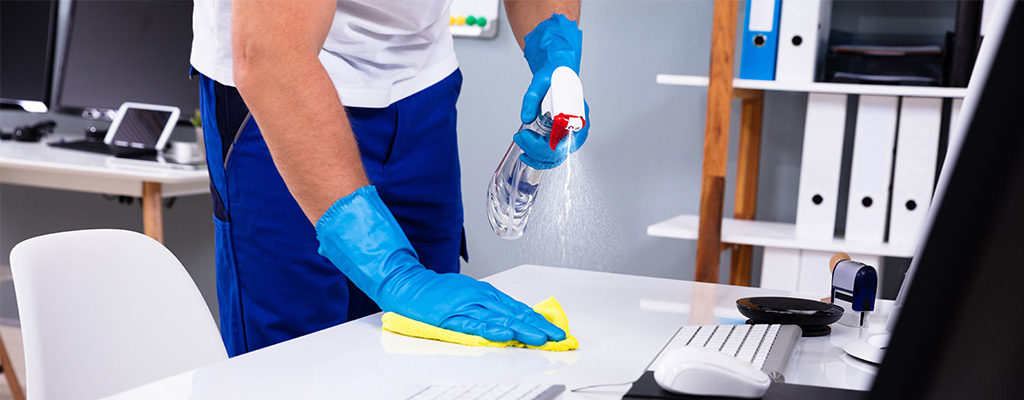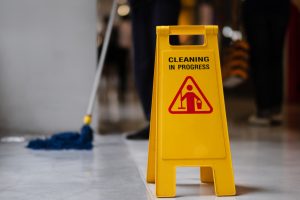
If you have a quick scan around your office right now, how clean does it look?
Are there files stacked everywhere? What about boxes lying about the floor? When were the bins last emptied?
Maintaining a clean office and workplace hygiene is vital for many reasons. Not only does it remove clutter from your place of work, but it also contributes to a happier and more focused workforce. If you have clients coming in for meetings, a clean office can make a big first impression. This can help boost your brand and ensure that anyone who is visiting leaves with a positive memory.
We’d all like a sparkling office environment but whose responsibility is it to provide this?
In this blog post, we are going to look at:
- Whether or not cleanliness falls under health and safety
- Keeping shared spaces clean
- Keeping individual workstations tidy
- How to maintain hygiene in the workplace
By the end of this blog, you’ll have a solid understanding of how important cleanliness plays in an office.
Is cleanliness a health and safety issue?
In a word, yes.
OK, so you have probably heard of the Health and Safety at Work Act, right? It’s been around for a while- 1974 to be exact – and we mention it a lot on this blog.
You can use the link above to get the full document, but we’ll save you some trouble when it comes to office cleanliness. The act basically states that employers are legally bound to ensure that employees are looked after at work and cleanliness of the workplace would come under this.
Cleanliness falls under health and safety because not maintaining this can lead to a range of different problems. This can include employee’s becoming ill due to hygiene issues or tripping over objects left lying around in an untidy environment.
So, let’s look at how you can keep certain parts of the office clean.
Hygiene in the workplace
Hygiene in the kitchen
The kitchen can be one of the busiest and most used parts of any office.
After all, it is where people congregate on their lunch or to grab a cup of coffee. Due to the nature of the room, it can also prove to be one of the most hazardous. There is often a real health risk in a shared kitchen if a high level of cleanliness is not maintained.
We’ll look at how you can implement a culture of cleanliness a little later on; however, encouraging employees to take responsibility for their own mess can go a long way to creating a clean kitchen environment.
Some specific things that can be done to maintain hygiene in the kitchen include:
- Regularly wiping down surfaces such as worktops and appliances
- Checking for out of date food in the fridge
- Cleaning tables and floors
When it comes to poor hygiene, the kitchen can often be the worst places for this.
Hygiene at individual workstations
The employee that sits at a workstation should be encouraged to keep their own space clean and tidy.
In many cases, people hot desk, especially if an organisation hires several part-time employees who work different hours or days. While we’d all love to have a clear and sparking desk, this doesn’t always happen. Who can say that they never have a pile of files or paper lying around?
That being said, if each employee ensures that their desk is neat and tidy with a regular clean, then it shouldn’t cause any problems.
Involving everyone in work as part of a wider cleanliness discussing should go a long way towards creating a positive health and safety culture.
Maintaining hygiene in the workplace
As an employer, you also have a duty to provide certain things and maintain other parts of the office, including access to drinking water and ensure clean toilet facilities.
There are several policies and things that you can do, which will help to keep your workplace clean and tidy.
Create a cleanliness policy
Just sending round a vague email about keeping the office clean isn’t going to do much in the long term. How many emails do people get a day? Probably loads so you need to create a hygiene and cleanliness policy and make sure all staff are on board.
Communicating health and safety in the right way can make the difference from policies being appropriately implemented or simply ignored. In fact, IOSH Managing Safely Training touches on aspects of this.
Provide cleaning supplies
This goes without saying, really.
It isn’t up to your staff to bring in their own cleaning products for their workstations. If you provide all of these items, then they will be far more likely to make an effort and ensure that the office, in general, is kept clean.
Hire a cleaner
We all get busy, and it can be difficult at certain times for staff to take time out of their day to clean communal spaces such as the kitchen or the hallway.
You can make up a cleaning rota or better still (if you can), hire a cleaner. They don’t necessarily need to clean every day but even coming in a couple of days a week to do a ‘big clean’ can make such a difference. One suggestion is to have a cleaner look after the communal space a couple of times a week and put the emphasis on staff to make sure their individual desks are tidy.
The cost of slips
For many businesses, the cost of investigating, defending and ultimately paying out in civil claims for slips in their workplace can seriously dent their profit. Network Rail, for example, paid out £1million over five years for slips, trips and falls across their 31 stations.
The article mentions a variety of reasons for the slips: liquid, ice and even bird faeces have all been causes of slips, with compensation for each slip reaching up to £36k. While there are many ways to approach this problem, cleaning could play a part in the solution. We spoke with Christian Harris from Slip Safety Services, an organisation that works with a wide range of companies in different sectors to reduce the risk of slips to staff and members of the public.
“One aspect of cleaning that people often miss is its effect on slip safety. Whilst a clean, dry floor is almost certainly slip resistant, if a floor becomes wet or contaminated and it hasn’t been maintained well, slip risk can skyrocket. It’s always worth using a pendulum slip test to quantify the effect of your cleaning regime on your floor’s safety.”
The HSE (Health and Safety Executive) have produced general guidance on workplace safety for smaller low-risk businesses to help you comply with health and safety law.

Cleanliness and health and safety at work
Not many people like cleaning.
However, in the workplace and especially in an office, having a clean environment is essential. It can become a serious health and safety issue if an office has very poor hygiene. It can lead to people being sick or even if it is just messy, there are many hazards that cause serious issues.
The Health and Safety at Work Act 1974 and The Workplace (Health, Safety and Welfare) Regulations 1992, dictate that employers have to make sure that your place of work is kept ‘sufficiently clean and tidy.’
The best way to ensure a clean office that is safe for everyone is to not only fulfil your duties as an employer but also to create a ‘clean culture’ to encourage your staff to take on responsibility too.
Health and Safety training for staff
Health and safety training is a highly valuable investment for staff as it prioritises their well-being and fosters a safe working environment. By providing comprehensive training on best practices, hazards, and emergency procedures, employees gain the knowledge and skills to mitigate risks, prevent accidents, and respond effectively to potential dangers.
IOSH Working Safely courses
The IOSH Working Safely course is suitable for employees at all levels and in all industries. You do not need any prior knowledge or understanding of health and safety to attend this course, as IOSH Working Safely was developed to create a common understanding of health and safety among employees from entry-level positions to Managers and Supervisors. Whether you have an office-based role, factory, manufacturing plant, retail or any other work environment, this 1-day course will provide you with essential knowledge and skills to contribute to safer working.
IOSH Managing Safely courses
If you are a leader of a team, manager or supervisor, then the IOSH Managing Safely course is for you. The course is suitable for all industries and sectors, as it will provide you with a broad foundation of health and safety understanding, suitable for someone who has a responsibility for others at work. This course runs over 3 days and you will learn essential knowledge and skills to effectively manage health and safety in your workplace.
NEBOSH General Certificate
This qualification is beneficial if you have a health and safety responsibility at work. Gaining this certification will demonstrate that you have a solid understanding of health and safety principles and best practice. This qualification is the equivalent to an A-level qualification, and the course runs over 2 weeks. It is an investment, however, it shows that you are dedicated to raising the health and safety standards in your workplace by having someone in your organisation with this qualification. You can read more about the NEBOSH General Certificate in our blog ‘Should I do a NEBOSH General Certificate?’.

